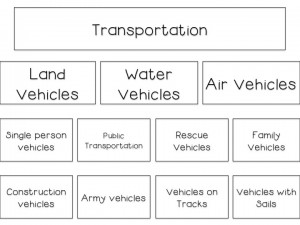Categorization is another one of my favorite goals to work on. Categorization is really a fundamental skill which helps direct our thought processes. We use categorization to plan events, organize our homes, create shopping lists and navigate stores efficiently. In order to categorize objects appropriately, we need to be able to recognize similarities and differences between objects and then group the objects appropriately. I use categorization activities with students who have poor vocabulary, difficulty with comparing/contrasting, organizational challenges, Executive Function disorders, Autism Spectrum Disorders and limited flexibility.
I usually start working on sorting tasks using real objects. I start by demonstrating main category groups. Can they sort the objects by animals, food, clothing etc? A lot of my clients diagnosed with Autism spectrum disorders tend to do very well with this task. It’s another reason why I like to choose the goal-it’s nice to feel some success in therapy. I also try to have a few examples of each target to work on object concepts. For example, I may have 5 different breeds of dogs. Then we can work through each characteristic and come up with the concept of “dog”
Once they understand the main category groups, then I expand to sorting by attributes. So we work on sorting by color, size, shape, stripes/no stripes etc. As we go through these tasks, I make sure to model what I am seeing: Dinosaur goes in this box because he is big. The zebra has stripes, I’m going to put him in with the other animals who have stripes.
My next step is usually sub categories and sub-sub-categories. I will name the category and then put out the objects. I’ll set it up as a challenge: can you sort these items into these 3 baskets? If they are able to do that, then I will challenge them to sort them again using different subcategories. In addition to working on the categorization, we are also working on flexibility and creative thinking.
I tend to stick to 3-4 big main categories (food, animals, transportation, clothing.) It is fun to see if your clients can sort more complex categories: for instance can they think of three ways to sort instruments?
By Category (woodwind, stringed instruments)
By Material (wood, brass, etc)
By method of sound production (blow into it, use a bow on strings, pluck it, bang it.)
Once we have made it through these goals, then we start working on more traditional categorization using mediated learning techniques. I really like the Entire World of Categories books for ideas of how to prompt and question students during these activities.
There are category object kits that you can buy but I’ve found it helpful to create my own. I like the Safari toobs for realistic objects for vehicles, animals, nature items and instruments. They are around 10-11.00 retail priced but I used 50% off coupons at a local craft store to expand my collection. I just bought a set with the coupon every other month so it didn’t feel like I was spending a lot.
What are your favorite ways to work on categorization?





[…] Today is World Autism Day. I’m lighting it up by changing my font color to blue. Last year when I wrote this, the prevalence was 1 in 88 children. This year that prevalence has changed to 1 in 68. Autism impacts a child’s ability to interact with their world and to process the information within that world. About 50 percent of my caseload for the past 15 years has been children and young adults on the Autism Spectrum. Because it is a spectrum disorder, abilities range from severe to mild. I worry that even my children who are “higher” will have difficulty managing as adults. In general, these are smart children who need help to figure out how to manage within a confusing world. One of the challenges as professionals is to help prepare them to live successfully within that world. Last year, I wrote several posts during Autism awareness month. Here are some of them: Autism and Eye ContactEcholaliaCategorization […]